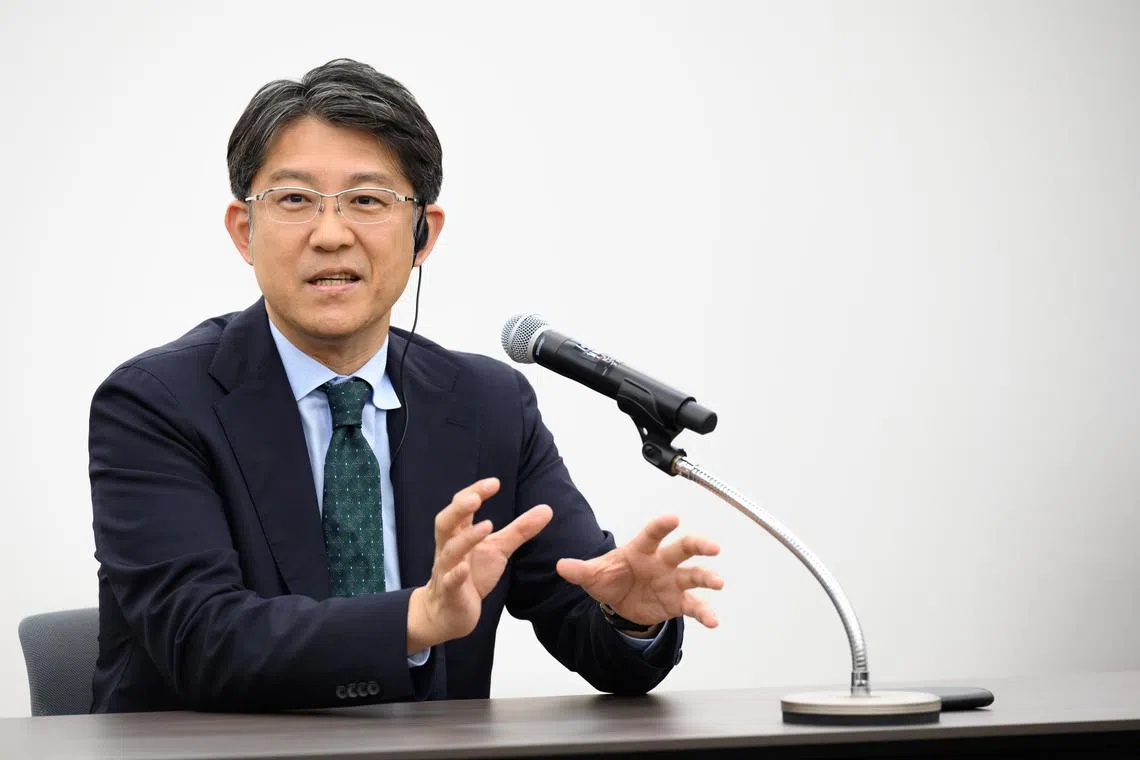New Toyota chief Koji Sato wants to drive Asia’s green transformation
Sign up now: Get ST's newsletters delivered to your inbox

Toyota Motor president and chief executive Koji Sato speaking to the media at the company's headquarters in Tokyo on April 21.
PHOTO: TOYOTA MOTOR
Follow topic:
TOKYO – Toyota Motor, the world’s biggest automaker and Japan’s most valuable company by market capitalisation, has been dismissed by analysts as a laggard in the development of battery electric vehicles (BEVs).
But president and chief executive Koji Sato has stressed that there are multiple pathways to the company’s ultimate goal of achieving net-zero carbon emissions by 2050.
“It’s not about the number of BEVs that we sell, but about how much Toyota is able to reduce carbon emissions,” he said in response to a question by The Straits Times at a small group interview with the media on Friday.
The 53-year-old is a through-and-through Toyota man who joined in 1992 and succeeded family scion Akio Toyoda as chief on April 1
While Toyota has failed to keep pace with companies such as Tesla of the United States and China’s BYD in the development of BEVs, he said this was not the be-all and end-all in the race for industry dominance, given that regions such as developing Asia lack the necessary infrastructure for electric vehicles.
“Perspective is very important. We need to think about the entire planet in order to achieve carbon neutrality, and the solutions must match the speed of development and the needs of each region,” he added.
“For example, there are countries with no power infrastructure. If we try to introduce BEVs there, we will not bring any convenience to customers, especially if infrastructure construction cannot keep up.”
Toyota is the world’s largest automaker by sales, moving 9.57 million units globally in 2022. But just 0.26 per cent of this figure, or 24,466 vehicles, were BEVs.
At a news conference earlier in April, Mr Sato said that Toyota will launch 10 new BEV models by 2026, with the aim of selling 1.5 million units a year.
“When we look at our global business portfolio, we have to look at the needs of each region and be practical to promote electrification in each market,” he said, adding that the US, China and Europe are key markets for BEVs.
“We’ll need to adjust to different speeds and have different solutions that we can offer for each of these different regions, especially for Asia.”
Mr Sato insisted that going green has long been a key focus for Toyota, which had already cut carbon emissions by 30 per cent between 2000 and 2019 with its development of hybrid vehicles.
The next step is to slash emissions by a further 50 per cent by 2035, with the ultimate aim of achieving carbon neutrality by 2050.
To achieve this, one priority is to popularise hybrid vehicles, including plug-in models, across Asia as a transitional means towards carbon neutrality, he said.

Bz Sport crossover concept car (right) and Bz FlexSpace concept car (left) on display at the Toyota company booth, in Shanghai.
PHOTO: EPA-EFE
Toyota will proactively work with local partners to create the necessary infrastructure.
One recent example Mr Sato highlighted was a partnership with Thai conglomerate CP Group to develop a multi-pronged approach towards carbon neutrality, including hydrogen energy.
“BEVs are just one of many solutions towards our ultimate aim of carbon neutrality, and we are steadily taking steps towards realising this as early as possible,” he said.
Looking towards the future, he sees potential in petrol-guzzling heavy-duty vehicles such as lorries being replaced with hydrogen fuel-cell powered versions.
In Toyota’s push towards becoming a “mobility company”, Mr Sato also described his vision for cars to become a more prominent part of social infrastructure.
Noting that cars are driven only 20 per cent of the time and stay parked for the other 80 per cent, he said: “Imagine if we can generate value from the car as it is parked, say, if it can evolve into a contributor to the power energy grid when it is not being driven.”
Mr Sato also wants Toyota to explore new frontiers of vehicles such as in the sky and in the sea.
He added: “We want to be involved in all kinds of mobility in the future.”


